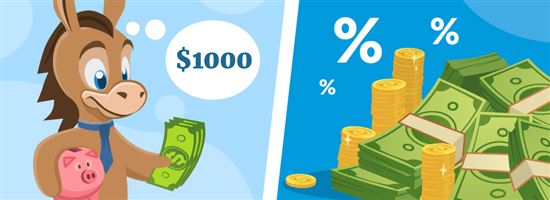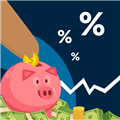How Much Will $1,000 Make in a High Yield Savings Account
Ad Disclosure: This article contains references to products from our partners. We may receive compensation if you apply or shop through links in our content. This compensation may impact how and where products appear on this site. You help support CreditDonkey by using our links.
Want to grow your money with a high-yield savings account? Continue reading to know how much you can earn.
 |
If you want to make your money work harder, opening a high-yield savings account is a great option. Many banks offer impressive rates that can help you boost your funds.
But how much money can you really make with a high-yield savings account? Read on to find out.
How Much Will $1,000 Make in a High-Yield Savings Account?
If you leave $1,000 in a high-yield savings account with a 5% APY, you can earn around $50 in 12 months. However, the total amount you can make depends on several factors like interest rate, initial deposit, additional contributions, and how long you save.
You can also use this savings calculator to find out how much money you can make with different interest rates and initial deposits:
Is a High-Yield Savings Account Worth It?
A high-yield savings account is worth it if you want to grow your money without much effort and still have easy access to your funds.
It's a secure and practical tool for short-term goals such as emergency funds, vacations, and paying off debts. However, if you're looking for high returns, you're probably better off with other forms of investment.
A high-yield savings account offers better rates than a traditional one, usually with no fees or balance requirements. Additionally, deposits are protected up to $250,000 with FDIC insurance.
Can You Lose Money in a High-Yield Savings?
Generally, you can't lose money in a high-yield savings account. This is because most savings accounts are protected by FDIC insurance up to $250,000 per depositor, per ownership category.[1] So, even if the bank fails or closes, you are guaranteed to get your money back.
However, keep in mind that paying monthly fees and overdraft charges can reduce your balance.
How to Choose a High-Yield Savings Account
Many high-yield savings accounts are available today, but choosing the best one can be tricky. Consider these factors to help you decide.
- Good APY
The most important thing is to choose a bank that offers good APY. Just note that some accounts with high rates have many restrictions or requirements that aren't worthwhile in the long run. - Maintenance Fees
Consider fees when you do your research. Some banks have monthly charges that can lower your account balance. The best thing to do is to compare fees so you can minimize the risk of losing money. - Account Requirements
Balance and deposit requirements are important factors when searching for a high-yield savings account. Some banks may have conditions that can be restrictive if you don't have enough funds to meet or maintain them.
CIT Bank Platinum Savings - $300 Bonus
- APY: 4.10% APY with a balance of $5,000 or more
- Monthly Fee: $0
- Minimum Deposit to Open: $100
High Yield Savings Account - 4.25% APY
- APY: 4.25%
- Monthly Fee: $0
- Minimum Deposit to Open: $1
Do You Pay Taxes on High-Yield Savings?
The interest earned on your high-yield savings account is subject to taxes. This is because the IRS considers it as taxable income regardless of whether you keep it in your account or withdraw it. You will have to fill out a tax form and report the payments of interest if your total earnings exceed $10.[2]
Alternatives to High-Yield Savings Accounts
If you're unsure about opening a high-yield savings account, here are other options to consider:
- Certificate of Deposit
A CD is best for those who are fine with keeping their money locked up in exchange for a fixed, competitive rate. This means you can't access your funds pre-maturely or else you'll be penalized with early withdrawal fees. - Money Market Account
A money market account offers a competitive rate and may provide convenient access to your funds through electronic transfers, debit cards, and check-writing. However, some banks may require an initial deposit or a minimum balance. - High-Yield Checking Account
A high-yield checking account is ideal for those who want to earn interest on their spending account balance. You can enjoy a decent APY and easy access to your funds through a debit card, check, or ATM.
Bottom Line
With a high-yield savings account, the total amount you make ultimately depends on factors like interest rate, initial deposit, contributions, and duration of savings. You could earn around $50 with $1,000 in your account at 5% for a year.
Thus, it is a useful tool for those who want to speed up their savings process. But, if you want higher returns, you can check out other investment alternatives out there.
References
- ^ FDIC. Deposit Insurance, Retrieved 02/14/2024
- ^ IRS. Topic No. 403, Interest Received, Retrieved 12/23/2023
Write to Darlene Santos at feedback@creditdonkey.com. Follow us on Twitter and Facebook for our latest posts.
Note: This website is made possible through financial relationships with some of the products and services mentioned on this site. We may receive compensation if you shop through links in our content. You do not have to use our links, but you help support CreditDonkey if you do.
|
|
|













